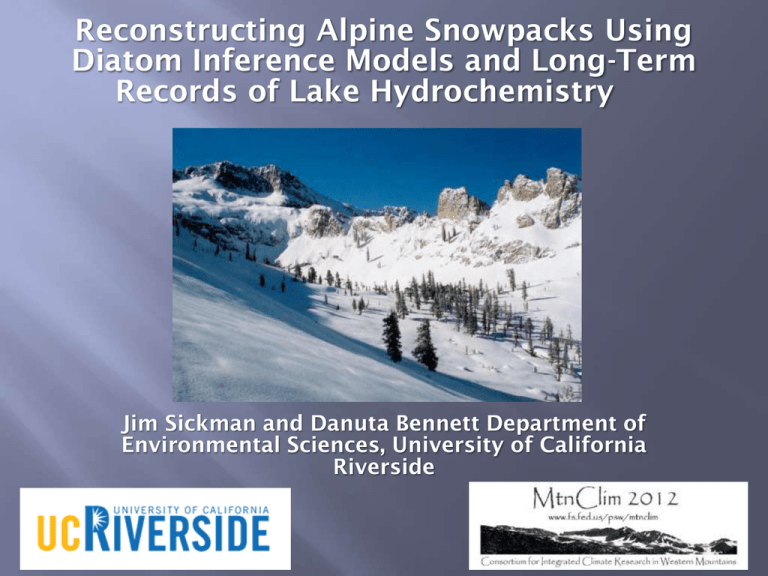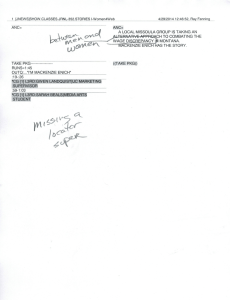Reconstructing Alpine Snowpacks Using Diatom Inference Models and Long-Term
advertisement

Reconstructing Alpine Snowpacks Using Diatom Inference Models and Long-Term Records of Lake Hydrochemistry Jim Sickman and Danuta Bennett Department of Environmental Sciences, University of California Riverside Importance of seasonal snowpack The need for alternative snowpack proxies The influence of snowpack on lake chemistry Sierra Nevada Cascades Rocky Mountains Diatom reconstructions of lake ANC and snowpack at Emerald Lake (1825-2010) Future directions Global Importance of Seasonal Snow Cover: • The mean area of seasonal snowpack in the Northern Hemisphere winter represents 61% of hemispheric land area (Armstrong and Brodzik 2005) • Seasonal snow cover comprises the largest component of the cryosphere and it is highly important to the Earth’s energy balance • The top of atmosphere radiative forcing for land-based snowpack is of the same magnitude as the forcing caused by sea ice and glaciers • Recent satellite-based observations suggest that the area of seasonal snow cover has declined since 1979 coincident with warming of the Northern Hemisphere (Flanner et al. 2011). MODIS Pardee Hetch Hetchy Reservoir Shasta Dam Reservoir Oroville Dam CVP Mokelumne River Aqueduct California Aqueduct Hetch Hetchy System SWP DWR San USGroundwater, Bureau Francisco of Reclamation Public Utilities East Bay Municipal Utility CA Department ofLocal Water Commission Central Valley&Project District Resources Resources Conservation Hetch 1940 Water -Hetchy 1st water System delivered Mokelumne River Aqueduct State Project 1913 (Contra - Raker CostaAct Canal) 1960 Burns Porter Act 1929 1973 - 1st water to So.Cal. Climate Change - Predicted Changes in Inflows to Delta higher winter peaks On-going shift in runoff timing toward winter, extending low-flow periods – 1/3 loss of snowpack by 2050 Increase in intensity and frequency of winter runoff events drier summer Change in inflows to Delta by 2060 (Knowles and Cayan, 2004) Pacific Maritime Snowpack is Also Sensitive to Inter-decadal Climate Variability: ENSO and PDO • Warm ENSO events associated with increased snowpack in the Southwest • Cold ENSO events associated with increased snowpack in the Northwest. A set of 42 tree-ring chronologies from California, Nevada, and Oregon were used to develop a regression model to predict historical flows in the Sacramento River. Meko, D. M. 2001. Reconstructed Sacramento River System Runoff From Tree Rings. Report prepared for the California Department of Water Resources, July 2001. Ring characteristics are primarily set during the growing season, so climate variability in the winter has less influence (e.g., summer monsoon vs. winter snowfall) Trees near treeline may be more affected by temperature variations than snowfall variations Trees at mid-elevations may be more waterlimited, therefore ring characteristics may more strongly reflect precipitation changes, but… -18 µEq/L -11 µEq/L Snowpack Water Equivalence (mm) April-1 EML ANC:Snowpack Relationship 1983-2011 3500 3000 1986 Avalanche 2500 2000 y = -106x + 4,329 R² = 0.85 1500 1000 500 0 0 10 20 30 September Lake ANC (µEq /L) 40 ANC:Snowpack Relationship 20 Sierra Nevada Lakes All lakes show snowmelt dilution of ANC Variation in ANC response to snowmelt dilution = -8.1 to -270 mm/µEq/L = 4.2 to 65 µEq/L change in ANC between wet and dry years Select “snowpack sensitive” Lakes for Paleo-reconstructions Less sensitive More sensitive ANC:Snowpack Relationship In Cascade Lake ANC:Snowpack Relationship In Rocky Mt. Lakes Diatoms High species diversity Well-defined ecological requirements Respond quickly to changes in lake chemistry Cell walls composed of silica are well preserved in sediments Psammothidium subatomoides Stauroneis construens Diatom Inference Model for Lake ANC ANC Time-series for Emerald Lake 2010 1930 1890 Field Observations 1850 Diatom Reconstruction 1.50 1.00 0.50 1810 0.00 ANC Anomaly (Relative to Mean ANC 1983-2010 and 1982-1825) Calendar Year (AD) 1970 Recall…. Snowpack Water Equivalence (mm) April-1 3500 3000 1986 Avalanche 2500 2000 y = -106x + 4,329 R² = 0.85 1500 1000 500 0 0 10 20 30 September Lake ANC (µEq /L) 40 Snowpack Time-series for Emerald Lake 2010 1930 1890 1850 1810 4000 2000 0 April-1 SWE mm (1825-2010) Based on EML ANC:Snowpack Relationship Calendar Year (AD) 1970 Validation of SWE Reconstruction Strengths: Method relies on a hydrochemical proxy that is highly sensitive to changes in snowpack Method can be applied in regions where tree growth is less sensitive to precipitation (e.g., Cascades) Method can be applied in zones above the treeline Method may be most useful for identifying periods with above normal precipitation (e.g., Holocene glacial studies) Weaknesses: Temporal resolution is coarser than tree-ring records Method must be applied to lakes that exhibit strong sensitivity to snowmelt Method relies on lake-specific information regarding ANC:snowpack relationships (long-term data needed) Method requires diatom inference model of ANC Diatom species change substantially over century time scales, perhaps limiting the diatom reconstructions of SWE to hundreds rather than thousands of years The hydrochemistry of lakes is sensitive to the maritime Pacific snowpack Acid neutralizing capacity (ANC) strongly affects lake diatom species and its concentration is primarily controlled by: Rock weathering Snowmelt dilution of weathering products Diatom inference models can be used with lake-specific relationships between ANC & snowpack to reconstruct SWE from sediment cores Model is being applied to longer sediment cores and reconstructions are being validated by comparisons to dendroclimatic data Q U E S T I O N S ? ANC:Snowpack Relationship In Rocky Mt. Lakes

